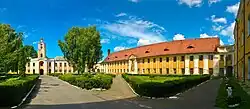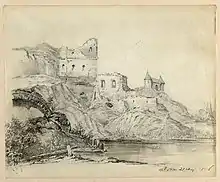Olyka Castle
Olyka Castle was the principal seat of the Radziwiłł princely family in Volhynia (nowadays in Ukraine) from 1564 until the late 18th century. The founder of the castle was Prince Mikołaj "the Black" Radziwiłł (1515–1565) who gave Olyka to his youngest son Stanisław. Two senior branches of the Radziwiłł family were based in Nesvizh and Kletsk.[1]
| Olyka | |
|---|---|
 The remains of the Radziwiłł estate in Olyka require urgent repair. | |
| Coordinates | 50°43′24″N 25°48′31″E |
| Built | 1564 |
| Built for | Mikołaj "the Black" Radziwiłł |
 Location of Olyka in Ukraine | |
The Olyka Castle was immensely influential as the first square fort with corner bastions in the Kresy (eastern territories of the Kingdom of Poland) and the prototype of many similar structures found in Eastern Europe. It was almost continuously under construction for eight decades and sustained numerous sieges between 1591 and 1648. It is probably the biggest aristocratic residence in Ukraine, with 365 rooms.[2]

During Napoleon's invasion of Russia a Russian military hospital moved in and continued in use until 1837.[3] An 1840 document refers to the castle as untenanted. In 1883, a campaign of restoration was launched but it was not taken to its conclusion until after the First World War.
The Olyka Castle comprises four residential buildings of unequal height, forming a court in the middle and encircled by a moat.[4] The towers of the original castle have crumbled to the ground, but the network of bastions is still in place. The main palace of three storeys, although originally built in the 16th century, is essentially the upshot of renovations carried out in the 17th and 18th centuries.[4]
Other buildings of the castle complex include a 17th-century gateway, a two-storey clock tower, and the Collegiate Church of the Holy Trinity (1635–1640), an elaborate replica of Il Gesu.
During the German occupation of Poland (World War II), the Radziwiłł Fortress was the site of Nazi German persecution of Ołyka Jews in the Holocaust. As part of the Einsatzgruppen action of August 1941, 720 Jews were murdered at the Olyka Castle and nearby.[5][6][7] In July 1942, several hundred more Jews were killed in the castle.[8] Memorials outside Olyka mark the place of execution of more than 4,000 Jews in Summer 1942 – in and around the Olyka ghetto, Radziwiłł Fortress, Olyka Castle, and surrounding areas.[9][10] Israel's Holon Cemetery also has a memorial to the murdered Jews of Olyka and surrounding areas.[11]
A psychiatric hospital, Volyn’s Hospital No. 2, is now located at the site of the Olyka Castle.[2][3] The only part of the castle currently closed for visitors is a chamber for the Princes and their servants.[2]
References
- "Architectural, Residential and Cultural Complex of the Radziwill Family at Nesvizh" (PDF). UNESCO World Heritage Centre/Government of the Republic of Belarus. Retrieved 16 July 2017.
- "Olytsky castle". Anga Travel. Retrieved 16 July 2017.
- "Olyka". Castles and Churches of Ukraine. Retrieved 16 July 2017.
- Памятники градостроительства и архитектуры Украинской ССР. В 4-х томах. Гл. редкол.: Н. Л. Жариков. -К.: Будівельник, 1983—1986. Том 2, с. 79-82.
- Dean, Martin (2012). Encyclopedia of Camps and Ghettos, 1933–1945 Volume II Ghettos in German-Occupied Eastern Europe Part B. Bloomington, IN: United States Holocaust Memorial Museum/Indiana University Press. pp. 1435–1436. ISBN 978-0253355997.
- "Holocaust Encyclopedia: Invasion of the Soviet Union, June 1941". United States Holocaust Memorial Museum. Retrieved 16 July 2017.
- "Online Guide of Murder Sites of Jews in the Former USSR: Wolyn region (until 1939 Poland)". The International Institute for Holocaust Research/Yad Vashem. Retrieved 16 July 2017.
- "Radziwiłł Fortress". Yad Vashem. Retrieved 11 July 2017.
- "YIU Field Course in Ukraine". Yahad-In Unum. Retrieved 16 July 2017.
- "Commemoration of Jewish Victims". Yad Vashem. Retrieved 25 July 2017.
- "A stone monument in memory of the Jews of Olyka and its surroundings, who perished in the Holocaust". Ghetto Fighters' House Archives. Retrieved 16 July 2017.
External links
 Media related to Radziwiłł Castle in Olyka at Wikimedia Commons
Media related to Radziwiłł Castle in Olyka at Wikimedia Commons
